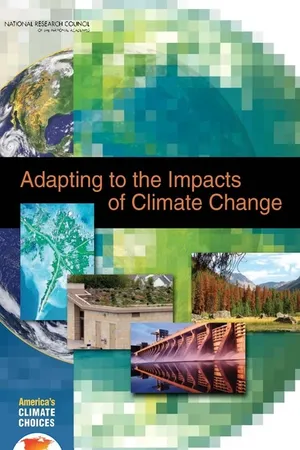About this book
Across the United States, impacts of climate change are already evident. Heat waves have become more frequent and intense, cold extremes have become less frequent, and patterns of rainfall are likely changing. The proportion of precipitation that falls as rain rather than snow has increased across the western United States and Arctic sea ice has been reduced significantly. Sea level has been rising faster than at any time in recent history, threatening the natural and built environments on the coasts. Even if emissions of greenhouse gases were substantially reduced now, climate change and its resulting impacts would continue for some time to come.To date, decisions related to the management and protection of the nation's people, resources, and infrastructure have been based on records in the recent past, when climate was relatively stable. Adapting to the Impacts of Climate Change, part of the congressionally requested America's Climate Choices suite of studies, calls for a new paradigm-one that considers a range of possible future climate conditions and impacts that may be well outside the realm of past experience.Adaptation requires actions from many decision makers in federal, state, tribal, and local governments; the private sector; non-governmental organizations; and community groups. However, current efforts are hampered by a lack of solid information about the benefits, costs, and effectiveness of various adaptation options; climate information on regional and local scales; and a lack of coordination. Adapting to the Impacts of Climate Change calls for a national adaptation strategy that provides needed technical and scientific resources, incentives to begin adaptation planning, guidance across jurisdictions, shared lessons learned, and support of scientific research to expand knowledge of impacts and adaptation.
Frequently asked questions
- Essential is ideal for learners and professionals who enjoy exploring a wide range of subjects. Access the Essential Library with 800,000+ trusted titles and best-sellers across business, personal growth, and the humanities. Includes unlimited reading time and Standard Read Aloud voice.
- Complete: Perfect for advanced learners and researchers needing full, unrestricted access. Unlock 1.4M+ books across hundreds of subjects, including academic and specialized titles. The Complete Plan also includes advanced features like Premium Read Aloud and Research Assistant.
Please note we cannot support devices running on iOS 13 and Android 7 or earlier. Learn more about using the app.
Information
Table of contents
- FrontMatter
- Foreword: About America’s Climate Choices
- Preface
- Acknowledgments
- Contents
- Summary
- 1 Introduction
- 2 Vulnerabilities and Impacts
- 3 What Are America’s Options for Adaptation?
- 4 Managing the Climate Challenge: A Strategy for Adaptation
- 5 Linking Adaptation Efforts Across the Nation
- 6 Rationale and Mechanisms for Global Engagement in Climate Change Adaptation
- 7 Major Scientific and Technological Advances Needed to Promote Effective Adaptation to Climate Change
- 8 Conclusions and Recommendations
- References
- Appendix A: America’s Climate Choices: Membership Lists
- Appendix B: Panel on Adapting to the Impacts of Climate Change: Statement of Task
- Appendix C: Panel on Adapting to the Impacts of Climate Change: Biographical Sketches
- Appendix D: Explanation of the Rationale for Reasons of Concern
- Appendix E: Acronyms and Initialisms
